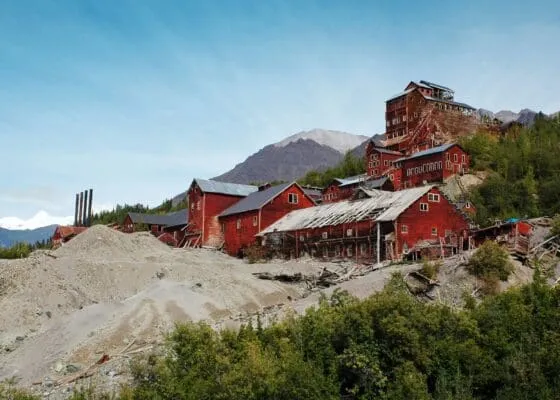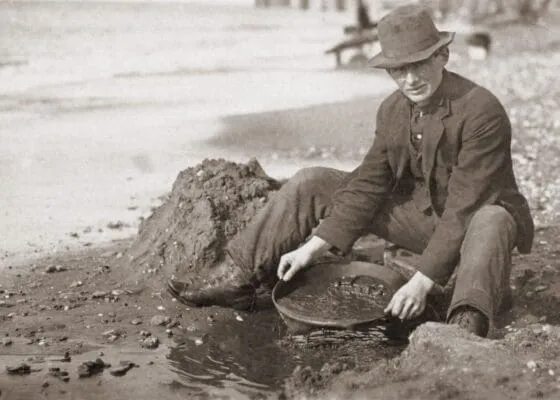Alaska, known as “The Last Frontier,” is famed not only for its breathtaking natural beauty but also for its captivating gold mining history. Among these tales, the Klondike region, with its historic gold rush in the late 19th century, stands as a symbol of wealth, adventure, and dreams of fortune. This article takes you back in time to explore the dynamic history of gold mining in the Klondike region of Alaska, from its early beginnings to the enduring legacy that resonates today.
The Klondike Gold Rush: Sparking Alaska’s Mining History

The history of gold mining in Alaska is inextricably linked to the world-shaking event: the Klondike Gold Rush. In August 1896, George Carmack and his group, including Skookum Jim and Tagish Charlie, discovered gold at Bonanza Creek, a tributary of the Klondike River in the Yukon Territory, Canada (an area that later became part of Alaska). News of this discovery spread rapidly, igniting like wildfire the dream of instant wealth in the hearts of thousands worldwide.
The Klondike Gold Rush officially began in 1897 when ships laden with gold arrived at the ports of Seattle and San Francisco, carrying tales of unbelievable riches. Tens of thousands of people, from all walks of life—farmers, laborers, intellectuals, and daring adventurers—flocked to the Klondike hoping to strike it rich. They were called “stampeders,” and their journey to the Klondike was an epic of perseverance, courage, and often, despair.
To reach the Klondike, gold seekers faced immense challenges. There were two main routes:
- The Sea Route: Sailing from Seattle or San Francisco to Skagway or Dyea, Alaska, then crossing the treacherous Chilkoot Pass or White Pass to Lake Bennett, and finally down the Yukon River to Dawson City, the heart of the Klondike. This route was longer but less geographically hazardous.
- The Overland Route: Trekking overland from Edmonton, Canada, across thousands of miles of wilderness, traversing the Chilkoot or White Pass. This route was shorter but incredibly arduous, demanding physical strength and meticulous preparation.
Regardless of the chosen route, gold seekers faced harsh weather, treacherous terrain, food shortages, and disease. Thousands perished en route or in the Klondike, yet the dream of gold continued to drive them forward.
Dawson City: Heart of the Gold Rush

Dawson City, situated at the confluence of the Klondike and Yukon Rivers, rapidly transformed from a small settlement of the Han people into a bustling city, the epicenter of the gold rush. Dawson City’s population skyrocketed from a few hundred to over 30,000 in just a few years. The city sprang up quickly with saloons, casinos, brothels, and stores, catering to the needs of gold seekers and those who came to profit from the gold rush.
Life in Dawson City during the gold rush years was extremely harsh. Living conditions were poor, the cost of living was exorbitant, disease was rampant, and law enforcement was lax. However, the city was also filled with energy and excitement. Gold was the topic of conversation everywhere, from saloons to streets. The lucky few who struck it rich became wealthy overnight, while the majority struggled to make a living or left empty-handed.
Dawson City was not only the economic center but also the cultural hub of the Klondike region during the gold rush. Theaters, clubs, and entertainment venues mushroomed, meeting the entertainment needs of the residents. Jack London, the famous writer, lived in the Klondike and drew inspiration from life there to write his famous works such as “The Call of the Wild” and “White Fang.”
Impact of the Klondike Gold Rush
The Klondike Gold Rush was not just a historical event unique to Alaska or Canada; it had a profound impact on the economy, society, and culture of the region and the world.
- Economic Impact: The gold rush brought significant resources to Alaska and Canada. Gold mined from the Klondike contributed to boosting the economies of both nations. Simultaneously, the gold rush created numerous new business and employment opportunities, not only in mining but also in services, transportation, and trade.
- Social and Demographic Changes: The gold rush significantly altered the demographic structure of Alaska and Yukon. The influx of thousands of people from around the world transformed the region into a culturally and ethnically diverse area. However, rapid population growth also caused social problems such as crime, racism, and cultural clashes.
- Long-lasting Influence on Alaskan Identity and Culture: The Klondike Gold Rush deeply ingrained itself into the identity and culture of Alaska. Images of brave miners, bustling gold towns, and tales of fortune and adventure became an integral part of Alaskan history and culture. The gold rush also laid the foundation for Alaska’s modern mining industry and spurred the development of infrastructure and transportation in the region.
Decline of the Gold Rush and Lasting Legacy
The Klondike Gold Rush did not last forever. By 1899, news of new gold discoveries in Nome, Alaska, attracted the attention of many gold seekers. Gradually, prospectors left the Klondike to seek new fortunes in other lands. Dawson City gradually returned to its former tranquility, its population plummeted, and economic activities declined.
However, the legacy of the Klondike Gold Rush lives on to this day. The Klondike became a symbol of adventure, courage, and the dream of a better life. The stories of the gold rush are still recounted through books, films, and artworks. Dawson City, though no longer as bustling as before, remains a fascinating tourist destination, attracting visitors from around the world to explore the history and heritage of the gold rush.
From the Klondike Gold Rush, gold mining in Alaska developed in a more professional and organized direction. Large mining companies invested in modern technology and equipment to mine gold on an industrial scale. Gold remains one of Alaska’s important resources, contributing significantly to the state’s economy.
Klondike Gold Mining Today
Today, gold mining continues in the Klondike region, but without the “stampede” scenes of the past. Modern mining companies employ advanced methods to mine gold more efficiently and sustainably. In addition, tourism has become a significant economic sector in the Klondike, especially in Dawson City. Visitors can explore historical sites, museums, and participate in tours to discover the land of gold.
The history of gold mining in the Klondike region, Alaska, is a dramatic and captivating story, reflecting the aspirations, hardships, and successes of humanity in the journey to conquer nature and seek fortune. The Klondike Gold Rush is not just a historical event but also a vital part of Alaska’s cultural and economic heritage, and it continues to inspire future generations.
Conclusion
The history of gold mining in the Klondike region, Alaska, is not only a tale of glittering gold nuggets but also a story of brave people, grand dreams, and profound cultural and economic legacies. From the world-shaking gold rush to the modern mining industry, the Klondike remains a legendary land of gold, a compelling destination for those who want to explore the history and unspoiled beauty of Alaska. A journey to the Klondike will take you back in time, allowing you to feel the vibrant atmosphere of the gold rush and gain a deeper understanding of the fascinating history of gold mining in this “Last Frontier.”